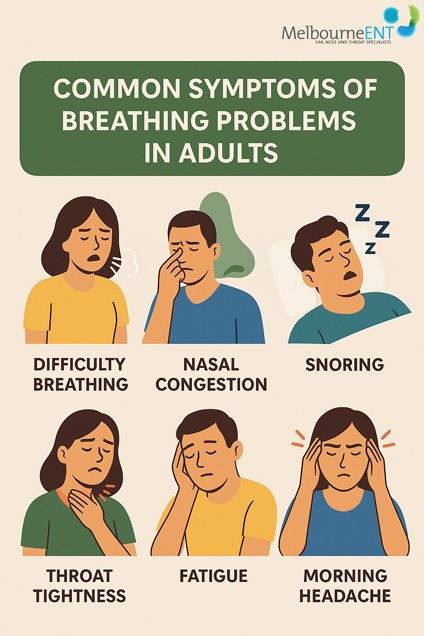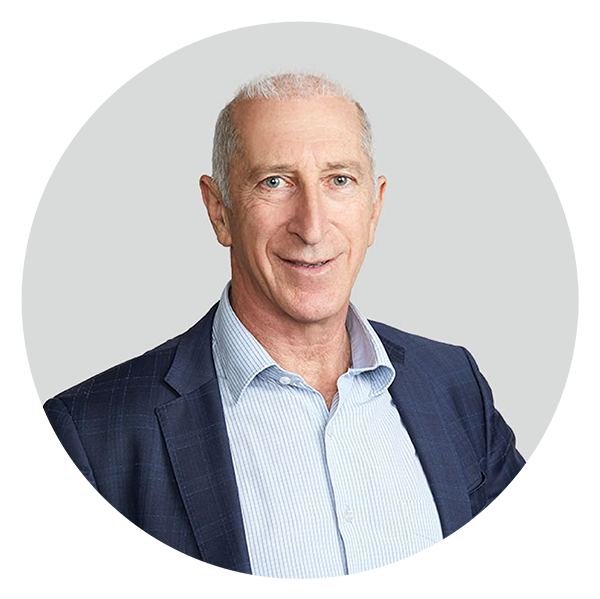
At Melbourne ENT, located in the heart of St Kilda East, Victoria, our specialist team is dedicated to helping adults overcome the often-debilitating effects of breathing difficulties. Led by Dr Stephen Kleid and Dr Simon Braham, both Fellows of the Royal Australasian College of Surgeons (FRACS), our clinic offers a comprehensive approach to ear, nose, and throat (ENT) issues.
With decades of surgical and diagnostic expertise, our team manages a wide range of airway and breathing concerns using the latest technology and evidence-based care. Whether you’re dealing with nasal obstruction, sleep-related breathing disorders, or chronic airway inflammation, we’re here to help restore your breathing comfort and overall quality of life.
What Are Breathing Problems in Adults?
Breathing problems in adults refer to any condition that interferes with the smooth passage of air through the nose, throat, or upper airways. These problems can range from mild nasal congestion to more serious conditions such as obstructive sleep apnoea or airway narrowing caused by structural abnormalities. Many patients may not realise how much their breathing is affected until symptoms become persistent, impacting sleep, concentration, energy levels, and even heart health.
The causes of breathing problems in adults are varied and can involve the nasal passages, the throat, or the voice box. Common structural issues include a deviated nasal septum or enlarged turbinates, both of which can significantly restrict airflow. Chronic inflammation from allergies or sinus infections can also cause ongoing nasal and airway blockage. In other cases, enlarged tonsils, adenoids, or tissue in the throat can limit airflow, especially during sleep. More serious conditions such as benign growths or even tumours in the head and neck region may also affect breathing, although these are less common.
Common Symptoms of Breathing Problems in Adults

The symptoms of adult breathing problems can vary greatly depending on the underlying cause, and they may present gradually or suddenly. Many patients first notice difficulty breathing through their nose, especially at night or when lying down. This can lead to chronic mouth breathing, which in turn contributes to dry mouth, bad breath, and poor sleep quality.
Throat-related symptoms may include a sensation of tightness or obstruction when breathing, particularly during sleep. Patients often report loud snoring, episodes of waking up gasping for air, or a feeling of choking during the night. These symptoms may be accompanied by a sore throat, hoarseness, or the need to frequently clear the throat.
Beyond the obvious breathing discomfort, many people experience more generalised symptoms. Daytime fatigue is one of the most commonly reported issues, especially in patients with sleep apnoea. They may feel unrefreshed after a full night’s sleep and struggle with concentration, mood changes, or morning headaches. Over time, these symptoms can impact personal wellbeing, work performance, and overall mental health.
Who is Affected by Breathing Problems?
Breathing problems can affect individuals of all ages, but certain populations are more likely to experience persistent issues. Adults in their 40s and older are more susceptible to sleep-disordered breathing due to natural changes in muscle tone and airway structure that occur with age. Men tend to be at higher risk for obstructive sleep apnoea, particularly those with a thicker neck or higher body mass index.
People who suffer from allergies or asthma often deal with chronic nasal or airway inflammation that exacerbates breathing problems. Those exposed to dust, smoke, chemicals, or other environmental irritants may experience chronic irritation and swelling of the nasal and throat tissues, making airflow more difficult. Anatomical predispositions such as a deviated septum or narrow nasal valve area are also common in individuals who have had breathing issues since childhood or adolescence but never sought medical evaluation.
In some cases, lifestyle factors also contribute. Smoking, obesity, and poor sleep hygiene can all worsen breathing problems. Even seemingly unrelated issues such as acid reflux or chronic stress can lead to throat muscle tension and a sense of restricted breathing.
Diagnosis and Evaluation at Melbourne ENT
At Melbourne ENT, we begin every diagnostic process with a detailed consultation. During your visit, your surgeon will take the time to understand the full history of your breathing concerns, including when they started, how they’ve progressed, and how they are affecting your daily life. Particular attention is paid to sleep patterns, daytime fatigue, nasal blockage, and any history of allergies, reflux, or infections.
A thorough physical examination follows, focusing on the nasal cavity, mouth, throat, and neck. This allows us to identify any visible abnormalities or swelling that might be contributing to your symptoms. We often perform a nasal endoscopy during this assessment. This minimally invasive procedure uses a fine, flexible camera to inspect the nasal passages and sinus openings in detail. It helps us detect any polyps, septal deviation, or enlarged turbinates that may not be visible during a routine exam.
In some cases, flexible laryngoscopy is used to examine the throat and vocal cords. This is especially useful when breathing problems are accompanied by voice changes or when there is suspicion of laryngeal involvement. For patients with more complex symptoms or suspected sinus disease, we may order a CT scan to provide a comprehensive view of the sinus and nasal anatomy.
If sleep apnoea is suspected, we collaborate with sleep specialists to arrange a home-based or laboratory sleep study. These tests measure breathing patterns, oxygen levels, and sleep quality to determine whether breathing is being interrupted during rest. Allergy and reflux testing may also be part of the diagnostic plan if inflammatory triggers are suspected.
Treatment Options for Breathing Problems
Treatment at Melbourne ENT is designed to address the root cause of your breathing difficulties. For many patients, non-surgical therapies provide significant relief. Medical management may involve nasal steroid sprays to reduce inflammation, antihistamines for allergic triggers, or decongestants to open the airways temporarily. Saline irrigation is often recommended to keep the nasal passages clear of allergens, mucus, and irritants. In patients with reflux, dietary modifications and acid suppression medications can help reduce throat inflammation.
For individuals diagnosed with obstructive sleep apnoea, continuous positive airway pressure (CPAP) therapy may be prescribed. This involves wearing a mask during sleep that gently forces air into the airway to keep it open. While CPAP is highly effective, it’s not suitable or tolerable for everyone, and in such cases, surgical alternatives may be explored.
Surgical treatment is recommended when structural abnormalities are the main contributor to symptoms. Septoplasty is a common procedure that straightens the nasal septum, improving airflow through both nostrils. Turbinoplasty reduces the size of enlarged turbinates, which are structures inside the nose that can swell due to allergies or infections. For patients with chronic sinus infections, functional endoscopic sinus surgery (FESS) may be performed to clear blocked sinus passages and restore drainage.
In cases where the throat or airway is obstructed, a tonsillectomy or adenoidectomy may be necessary. Other specialised surgeries such as nasal valve repair, laryngeal procedures, or tumour excision may be offered depending on the underlying diagnosis. All surgeries are tailored to the individual patient and performed with precision by our experienced team.
When is Surgery Recommended?
Surgical treatment is generally considered when symptoms persist despite comprehensive medical therapy or when the diagnosis clearly points to a physical obstruction that cannot be resolved non-invasively. For instance, if a deviated septum is causing unilateral nasal blockage or recurrent sinus infections, correcting the deviation surgically often results in long-term relief. Likewise, patients with significantly enlarged tonsils that obstruct airflow – particularly during sleep – may benefit from surgical removal.
Patients with moderate to severe sleep apnoea who cannot tolerate CPAP therapy may be candidates for airway surgery. This may involve soft tissue removal, palate reshaping, or more advanced procedures depending on the site of obstruction. Our surgeons work closely with each patient to ensure they understand the benefits, risks, and expected outcomes before proceeding with any intervention.
Recovery and Prognosis
Recovery times vary depending on the type of treatment, but most ENT surgeries are performed on a day-case basis or involve only a short hospital stay. For nasal surgeries like septoplasty or turbinoplasty, patients typically experience mild swelling and congestion for a few days, with most returning to work and light activity within one week. Full healing can take several weeks, during which breathing comfort steadily improves.
For throat surgeries such as tonsillectomy, recovery may involve more discomfort, particularly when swallowing. Pain management and hydration are key components of the post-operative care plan. Follow-up appointments are scheduled to monitor healing and ensure there are no complications.
The long-term outlook for patients treated for breathing problems is overwhelmingly positive. Most individuals report a significant improvement in sleep quality, energy levels, and overall breathing comfort. With expert care and personalised treatment, patients can expect sustained relief and a better quality of life.
Risks or Complications if Left Untreated
When breathing difficulties are left untreated, the consequences can be far-reaching. Chronic mouth breathing can lead to dental issues, dry throat, and poor sleep quality. Obstructive sleep apnoea, if ignored, has been linked to serious health problems including high blood pressure, heart disease, stroke, and diabetes. Ongoing fatigue and sleep disruption can impair cognitive function, reduce work performance, and strain personal relationships.
Structural abnormalities such as nasal polyps or deviated septum may also predispose patients to recurrent infections, making them more susceptible to sinusitis and bronchitis. In rare cases, undiagnosed masses in the airway can delay the detection of serious conditions. Early intervention by a skilled ENT specialist is key to avoiding these complications and preserving long-term health.
FAQs About Breathing Problems in Adults
Can chronic stress or anxiety cause my breathing to feel restricted, even if there’s no physical blockage?
Yes. Emotional stress and anxiety can lead to a sensation of tightness in the chest or throat and contribute to dysfunctional breathing patterns. While the airway may be structurally normal, the muscles involved in breathing may become tense, creating a feeling of shortness of breath. At Melbourne ENT, we assess both physical and functional causes of breathing issues to ensure a thorough diagnosis.
I’ve always had trouble breathing through my nose – could I have been born with a nasal deformity that’s only worsening with age?
Absolutely. Many adults unknowingly live with congenital issues like a deviated septum or narrow nasal valves, which may become more problematic with age or during allergy season. These issues are often correctable with modern ENT surgery once properly diagnosed.
Why does one side of my nose always feel more blocked than the other, and does it alternate?
This could be due to the natural nasal cycle, but persistent asymmetry may point to a deviated septum or turbinate hypertrophy. If you notice consistent one-sided blockage or it worsens with sleep, lying down, or exercise, it may warrant an ENT evaluation.
Can reflux from the stomach really affect my breathing and make my throat feel tight?
Yes. Laryngopharyngeal reflux (LPR) is a form of silent reflux that doesn’t cause heartburn but can irritate the throat and larynx. It often presents as chronic throat clearing, cough, or a sensation of something stuck in the throat – all of which may restrict airflow or mimic respiratory symptoms.
I’ve been told I snore loudly, but I don’t feel tired – could I still have a breathing disorder like sleep apnoea?
Yes. Not everyone with obstructive sleep apnoea experiences noticeable fatigue. Some patients are unaware of sleep interruptions but may still suffer oxygen desaturation or cardiovascular strain during sleep. If you snore loudly or have been observed choking or gasping at night, a sleep study may be beneficial even if you feel rested.
Can breathing problems impact my voice or ability to speak for long periods?
They can. Reduced nasal airflow, postnasal drip, or laryngeal irritation may affect your voice’s tone, strength, and endurance. This is especially relevant for people who use their voice professionally. Treating underlying ENT conditions often restores normal vocal function.
Is it normal to have breathing difficulty only during physical activity or while speaking for long periods?
Not always. Breathing discomfort that arises with exertion or speech may indicate narrowed nasal passages or upper airway resistance. It could also point to early-stage vocal cord dysfunction or subclinical airway inflammation. These subtle but significant symptoms are worth investigating with an ENT specialist.
Sources:
- Reactive Airway Disease: Causes, Symptoms & Treatment – Cleveland Clinic
https://my.clevelandclinic.org/health/diseases/24661-reactive-airway-disease - Pulmonary Conditions, Mankato – Mayo Clinic Health System
https://www.mayoclinichealthsystem.org/locations/mankato/services-and-treatments/pulmonology/conditions-we-treat - Asthma – Symptoms and causes – Mayo Clinic
https://www.mayoclinic.org/diseases-conditions/asthma/symptoms-causes/syc-20369653 - Shortness of breath Causes – Mayo Clinic
https://www.mayoclinic.org/symptoms/shortness-of-breath/basics/causes/sym-20050890 - Breathing and shortness of breath – Mayo Clinic Health System
https://www.mayoclinichealthsystem.org/topics/breathing - Dyspnea (Shortness of Breath): Causes, Symptoms & Treatment – Cleveland Clinic
https://my.clevelandclinic.org/health/symptoms/16942-dyspnea - Shortness of breath – causes, symptoms and treatments – Healthdirect (Australian government)
https://www.healthdirect.gov.au/shortness-of-breath
Concerned About Breathing Problems?
If you are struggling with persistent nasal congestion, snoring, interrupted sleep, or shortness of breath, now is the time to seek expert advice. At Melbourne ENT, our compassionate and highly skilled surgeons are here to help you identify the cause of your symptoms and provide targeted, lasting solutions. Every breath matters – and we’re here to ensure yours are as easy and effortless as possible.
To schedule a consultation, please contact us today at (03) 9038 1311.
Further Reading
- Read about Melbourne ENT’s Throat Concerns
- Read about Melbourne ENT’s Nose Concerns and Conditions
Why Choose Dr Kleid ?

Dr Stephen Kleid,
Melbourne ENT Surgeon
MED0001052799
Dr Stephen Kleid is an experienced ENT Surgeon (Otolaryngologist) based in Melbourne with a passion for Septo-rhinoplasty, Septoplasty and a strong interest in Rhinoplasty Revision.
Dr Kleid’s Procedures
Why Choose Dr Braham ?

Dr Simon Braham,
Melbourne ENT Surgeon
MED0001144757
Dr Simon Braham MBBS (Hons) FRACS is an experienced Ear, Nose and Throat ENT Surgeon (Otolaryngologist) based in Melbourne, performing tonsil, grommet and sinus surgery for children & adults. He helps patients with breathing issues, snoring concerns and sleep disturbances.
Dr Braham’s Procedures
How can we help?
Dr Kleid’s Team takes pleasure in assisting you with any questions when considering a plastic surgery procedure. Please call the St Kilda East clinic in Melbourne between 9am – 5 pm on Weekdays.
What Next?

Want more information about your Procedure?
- Please read our website and blogs to find out more about your procedure and concerns
- For more information about pricing and payment methods, please visit our page on Surgery Payment Options.
- Talk to our Patient Care Team from 9 am to 5 pm Monday to Friday

What to Bring to Your Consultation
- We encourage you to bring a friend or family member to accompany you, as they can provide an extra perspective and support throughout the process.
- It is important to take thorough notes and carefully review all the documents provided to you.

How to Book a Consultation
- A referral from your GP or Specialist is necessary to see a surgeon for a consultation.
- Dr Kleid’s Nose Surgery consultation fee is $600 which includes a nasendoscopy ($300).
- Please contact us today to book your consultation.

